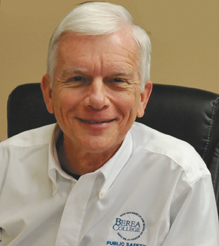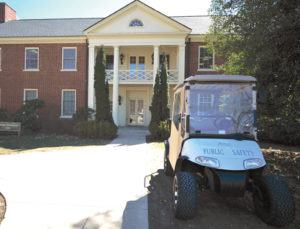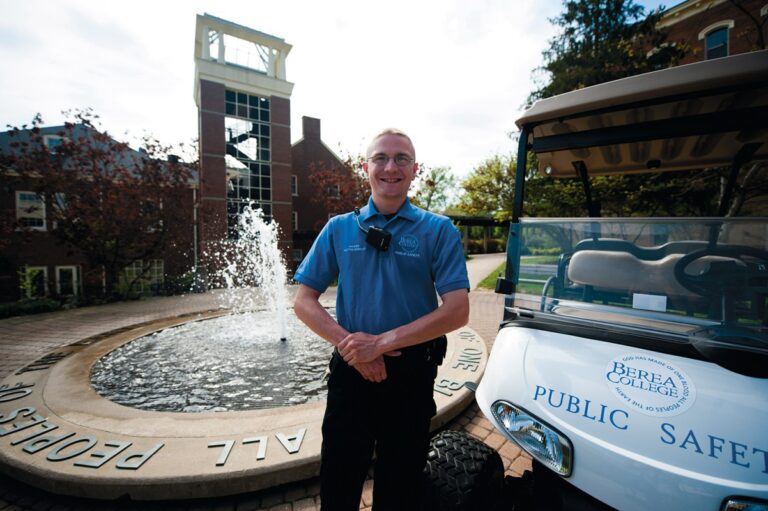During late summer, Berea College with its bright green grass and rich burgundy buildings is a beautiful and a serene place. As new students arrive on campus these calming elements, seem to say, “this is your new home.” While new students are generally excited about all of the opportunities in front of them, most also face some anxieties: “Who will I turn to for support?” “What will I do if I get sick?” “Where do I go if I need help?” And students are not the only ones with anxieties related to life on a college campus. Parents of new students often mix pride in seeing their sons and daughters begin college with worries about their safety. Though Berea has a long tradition of meeting these needs through the residence life program, health services, counseling, and other traditional means, the college continues to seek proactive solutions to the multifaceted problem of campus safety. On October 10, 2013, sixteen separate agencies descended on Berea College’s campus for an active shooter simulation. The primary participants were the Berea Police Department (BPD) and the Madison County Emergency Management Agency (MCEMA). Other agencies were there to evaluate the current response system, including the cohesion of communication during a crisis. Complete with student actors and actresses, law enforcement entered the Science Building in search of a “shooter.” The simulation included obstacles such as smoke filled rooms, student actors playing the role of victims, locked doors, and a decoy fire-alarm. ”We wanted to test our capacity to respond,” said director of public safety, Lavoyed Hudgins. “We tested our lockdown procedure, our incident command system, [our] communication.”

Current student Becky Lewis, believes such drills are reassuring: “Preparing for those things is a great idea, because you never know when that could happen… I think they [wanted] to get an idea of what they can and should do in an event like that and definitely to prepare the staff and students, faculty.” “We respond to everything from the mundane, to injuries [and] burglaries,” Lavoyed proclaimed. As director of public safety on campus, he is leading the campaign to make Berea safe. “We’re increasing our video surveillance and access control systems across campus. We are increasing our intrusion detection systems for many buildings,” he explained. Public safety also has a variety of programs and features set up to empower students to secure their environment. The first of these programs is E2Campus Alerts. This system sends out emergency alerts to participating students should something potentially dangerous occur on campus. During the active shooter simulation, alerts notified students of the proceedings as would occur if the event had been real. Lavoyed would “encourage everybody to sign up for E2Campus Alerts, [because] it’s a very important way to notify people.”

Green Dot is an international organization whose primary mission is the reduction of power-based personal violence. Green Dot trains bystanders by giving them the skills to safely intervene in potentially dangerous situations. Gus Gerassimides, assistant vice president for student life, says, “It could be sexual assault; it could be partner violence; it could be stalkers, anybody that intimidates or harasses people.” Since Green Dot has been present on Berea College’s campus, it has trained eighty students. “As you train more people, what ends up happening,” explains Gus, “is you get more people who are observant and then they start to take care of others in more constructive ways. It just raises awareness and it really gets the community more involved, because you give people the skills to get involved and identify this power-based personal violence.” As the Green Dot program approaches its second year on campus, it is encouraging students to come and learn how to make their community safer. From emotional abuse to physical violence, students can learn how to help their peers and themselves to create safer spaces. Swipecard system: The cards are programmed specifically for each individual student and allow only those who live in a dorm to access the building. If a card is lost or stolen, it only takes a few key strokes to deactivate the card and replace it.
Escort Program: “We provide escorts for students,” said Hudgins. “All they have to do is call Public Safety. Say it’s one in the morning and they’re a little concerned about walking to a certain area, we’ll come get them.”
Crosswalks: Upon accepting two students with visual impairments, the College improved the crosswalks by equipping them with audible signals: “wait” when it is not safe to go and “walk sign on for all crossings” when traffic is stopped.
Callboxes: Easily identified by the dome-shaped blue light on the top of the box, each has a large red button to be pushed in an emergency.Another new campus program that promotes student safety is T.R.U.T.H. talks. Hosted the Carter G. Woodson Center for Interracial Education, T.R.U.T.H. talks stands for True Racial Understanding Through Honesty. It was introduced “to build a safe climate” that would encourage students to engage in interracial activity. “For my students, I look at safety in terms of creating spaces where we can have different dialogues, but where students won’t feel attacked or ridiculed or demeaned if sharing concerns,” Monica Jones, Black Cultural Center director, expressed. “I am looking at safety in terms of more the emotional and social aspects of safety, not just in terms of physical safety.” One aspect of safety Monica cited as important was language. “Language is very powerful” because it shapes how a person is defined, Monica notes. By way of example, she noted that calling someone a “disabled person” puts a quality (disabled) ahead of their humanity. For Monica, it is essential that we learn to use language to “identify the person first.” While T.R.U.T.H. talks is an excellent place to find ideas like this, Monica notes that in the end safety is a personal responsibility. “It’s every individual’s responsibility to think in terms of, not just physical safety, but emotional and social safety as well. I’m trying to get folks to understand that we all have an active role in making sure that individuals feel welcome and safe on our campus. So, if you consider yourself a Berean, then you have to understand that inherently that’s part of what you do. You make others feel safe. And, sometimes it’s a simple as saying good morning.” While large initiatives may get more attention, less sensational programs, like call boxes and cross walk signals, are essential elements in the college’s continuous effort to improve the quality of life on campus. Safety is a complex issue, but by engaging the minds, hearts, and bodies of the campus community, the college ensures that its campus offers the most welcoming and safe space possible.


